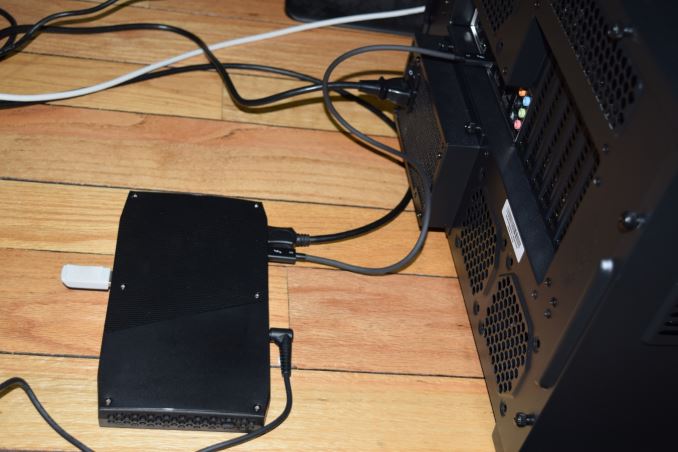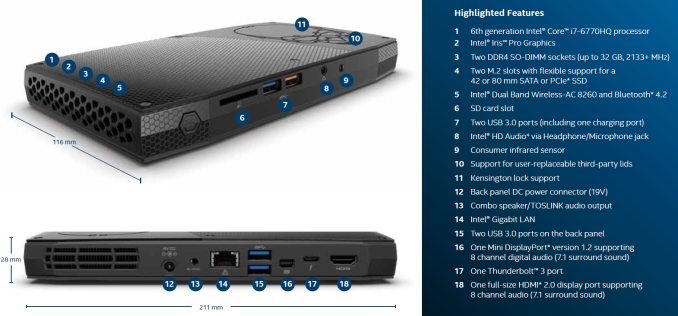The Intel Skull Canyon NUC6i7KYK mini-PC Review
by Ganesh T S on May 23, 2016 8:00 AM ESTMiscellaneous Aspects and Concluding Remarks
One of the more impressive aspects of the Skull Canyon NUC6i7KYK is the reappearance of Thunderbolt in a mini-PC. We have already covered Thunderbolt 3 in good detail. From the perspective of a Skull Canyon evaluation, the Thunderbolt 3 port does deserve a bit of attention. It must be noted that this USB Type-C port can also act as a USB 3.1 Gen 2 host port. Our evaluation of this feature is in two parts - we first hooked up a SanDisk Extreme 900 1.92TB USB 3.1 Gen 2 SSD and ran a quick speed test. We were able to see results similar to our review numbers, indicating that the USB 3.1 Gen 2 mode was indeed active. For the Thunderbolt part, we decided to check out Thunderbolt networking with our direct-attached storage testbed.
A Thunderbolt cable between two PCs is enough to create a Thunderbolt network
Connecting the Thunderbolt ports on the two machines and allowing the PCs to talk to each other automatically creates a 10Gbps network adapter. For a setup with just two machines, it is enough to just set static IPs on the interfaces of both machines in the same subnet, and setting the network location to private so that the machines can talk to each other. We configured a RAM drive on the testbed and mapped it as a network drive on the NUC6i7KYK, Running CrystalDiskMark on the mapped drive showed read speeds of 700 MBps and write speeds of 620 MBps, indicative of a 10Gbps link. The gallery below presents some screenshots of the benchmarks as well as the Thunderbolt networking setup steps.
Moving on to the business end of the review, let us get the complaints out of the way - While the size and form-factor of Skull Canyon are impressive, the acoustic profile is not that great. We would gladly trade a modest increase in the footprint of the system for lower fan noise. That said, the fan noise is in no way comparable to the BRIX Gaming lineup. It is just that it is not as silent as the traditional NUCs.
On the board layout front, we are unable to fathom why the CPU's PCIe lanes are not used at all. It would have been great to have a dual-port Alpine Ridge controller hang directly off the CPU's PCIe lanes. Finally, the ports on the chassis could have done with better spread. The two pairs of USB ports are such that one occupied port ends up making it difficult to utilize the other one in the pair. A port on one of the sides, or, on the lid (without relying on third-party designs), would be very welcome.
But with the above caveats in mind, Skull Canyon is definitely a great product. Simply put, it packs the most punch among systems with similar footprints. It is excellent for casual gamers, but, unfortunately, stops short of being a replacement for systems like the Zotac ZBOX MAGNUS EN970 or the ASRock VisionX 471D - two small form-factor PCs that integrate discrete GPUs at the cost of a larger footprint compared to Skull Canyon. The Thunderbolt 3 port, with an external GPU dock, can somewhat make up for the lack of a discrete GPU for gamers. However, the cost factor becomes a major issue. The 4C/8T configuration of the Core i7-6770HQ is also attractive to consumers looking for a small form-factor system with a powerful CPU, but, they must remember that some price premium is being paid for the Iris Pro graphics.
I am actually looking forward to what vendors like Zotac and ASRock can do with a similar design. If they could take a Skylake-H processor without Iris Pro (say, Core i7-6820HQ), and use the PCIe lanes off the CPU to hook up a mobile discrete GPU, it could deliver the best of both worlds - all the 45W TDP of the CPU can be used to provide raw processing power for CPU-intensive workloads, while a dGPU can handle graphics duties with a separate power budget.
To summarize, Intel has indeed managed to change the game with the NUC6i7KYK. A look at the increase in the gaming capabilities over the previous generation 'gaming' NUCs make the Skull Canyon updates to appear evolutionary in nature. However, the overall platform capabilities (including a much more powerful -H series CPU instead of a -U series CPU, as well as the integration of Thunderbolt 3 and dual M.2 PCIe 3.0 x4 SSD slots) are enough to justify the price premium ($650 for the barebones configuration).


















133 Comments
View All Comments
Kimo19 - Monday, May 23, 2016 - link
thanks a lot for the review. I am thinking to get this machine for photos editing (lightroom) and mobile development. would it be a good choice ? I was thinking the processor/ram/ssd are good enough to provide great performance for the next 2/3 years and the iris pro can be a good gpu to support monitor with high resolutionTheinsanegamerN - Monday, May 23, 2016 - link
For the price you could get something much more powerful, or something along the same power with better GPU support for a cheaper price then this NUC.fanofanand - Monday, May 23, 2016 - link
Keep in mind that you are bringing your own RAM and SSD, the kit does not include those items for the consumer. As for the iGPU providing support for high resolution, I think that will depend entirely on your workload.alpha64 - Monday, May 23, 2016 - link
Ganesh, Did you get confirmation directly from Intel that the PCI-E is limited on this system because it runs through the H170? From my research on ARK and other places, it appears that the H170 acts as a PCI Express passthrough, with a PCI express 3.0 x16 connection to the CPU, and the ability to split the configuration off to smaller widths and more ports coming off the H170. It would seem the DMI3 connection is for other (non-PCI express) peripherals. Granted, from the block diagram, it is not apparent that the H170 connects to the CPU's PCI-E x16 connection, but my guess is that it does.I would just like clarification, as this is a pretty big deal.
ganeshts - Monday, May 23, 2016 - link
I have confirmation from the technical marketing manager for NUC products at Intel that the communication link between the H170 and the CPU is only effectively PCIe 3.0 x4 for bandwidth purposes. It is definitely not a PCIe 3.0 x16.H170 itself can act as a PCIe switch, but, for anything that talks to the CPU, it has to go through the DMI 3.0 lanes.
alpha64 - Monday, May 23, 2016 - link
Thanks for the clarification!extide - Monday, May 23, 2016 - link
The 16 CPU lanes are entirely un-used in this device. The PCH (H170 in this case) is NEVER connected by a PCIe x16 link -- it is always connected via DMI 3.0 in the H, Q, B and Z platforms. DMI 3.0 has the same B/W as PCIe 3.0 x4. All of the stuff hanging off the H170 shares that same DMI 3.0 link.alpha64 - Monday, May 23, 2016 - link
Great to know, can you tell me what "Processor PCI Express Port" under "I/O Specifications" details are for on the Intel's ARK for the H170 part? I thought they were for connecting to the PCI Express on the CPU, but would be happy to learn if I am incorrect.Valantar - Monday, May 23, 2016 - link
I'm disappointed in the lack of teardown pictures. I was at the very least expecting a look at the cpu side of the board. Is that too much to ask?Also, considering the massive power throttling seen in your testing, and the torture test nature of the testing, I'd love it if you could monitor clocks and temps during gaming too - I'd be interested in seeing what kind of cpu clocks this can maintain in a low-threaded gaming workload.
allanmac - Monday, May 23, 2016 - link
Please run SGEMM on the HD 580 ... ASAP! :)https://software.intel.com/en-us/articles/sgemm-fo...